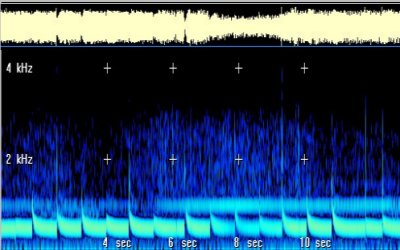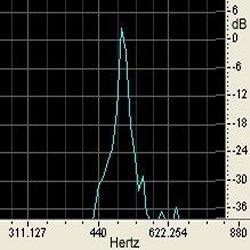Mystery Signals of the Short Wave
Dedicated to the more unusual, strange, bizarre and apparently meaningless signals on the short wave bands !
From the Archives
Russian Woodpecker | Yosemite Sam |
Site Information
What's New | About Me | Email |
Three Day Mystery
Frequency: 8625 kHz
An unusual signal appeared on 8625 kHz in July 2004, transmitted for for three days, then disappeared. All during the transmissions, the Royal Navy station, GYU in Gibraltar, could be heard behind the signal. GYU occupied 8625.5 kHz sending RadioTeleType (RTTY) signals 24 hours a day.
Day 1 - Tuesday 6 July 2004
Heard in progress at 1600 UTC, the signal sounded like a pulsing carrier, giving a laser type sound effect, punctuated by what sounded like tapping on a mike. There were approximately two pulses per second. The signal, about S3 in Southern England, had ceased by 2000 UTC.

Day 1 (56Kb)
Day 2 - Wednesday 7 July 2004
Heard in progress around 1615 UTC, the signal was present at the same strength, but today the pulsing was much slower - around one pulse every two to three seconds. Reports from monitors in South London, Bristol and Germany confirmed the signal. The signal ceased at 1730 UTC.

Day 2 (61Kb)
Day 3 - Thursday 8 July 2004
Heard in progress at 1500 UTC, (but reported from 1200 UTC), still giving an S3 signal. The pulsing was back to two pulses per second, but had slowed considerably by 1800 UTC. Signal ceased at 1830 UTC.
The signal did not reappear, although the carrier appeared on and off for several days without modulation.
Here is a simple sound spectral analysis of the signal. (Below Left)


Paul Beaumont of ENIGMA 2000 did a more detailed analysis of the signal and told me, "the signal might sound simple but it is a very complicated one. I find them a real mystery. I have looked at the sigs as both waveform and spectral and the answer is the same re the complexity."
"[Analysis] shows where the pulse is actually two pulses - you can see the join; hence the 'tap' noise."
Picture courtesy of Paul Beaumont (Above Right)